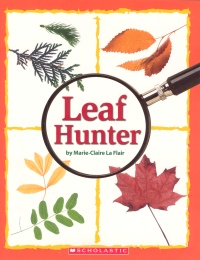| ________________
CM . . .
. Volume XII Number 7 . . . .November 25, 2005
excerpt:
Leaf Hunter is aimed at the individual purchaser, as opposed to the institutional buyer. Fundamentally, it is an album in which to display dried leaves. The bulk of its length consists of 23 pairs of facing pages, each pair devoted to a single tree with the opening five being coniferous and the remaining 18 deciduous. The left hand page in each pair of facing pages identifies the tree and provides a brief description of that leafís characteristics:
Also on that same page is an outline drawing of the leaf, and youngsters are to use it in identifying the leaves they are seeking or have found. The facing recto is where young naturalists are to glue in their pressed leaves. The book opens with two pages that briefly describe the materials needed to collect, dry and mount leaves, how to find and then press and dry leaves and finally how to mount the leaves in this book. The next two pages, via drawings, describe the anatomy of the leaves both of coniferous and deciduous trees as well as showing the differences between simple and compound leaves. In the bookís final two pages, Marie-Clair La Flair lists the official trees of Canada and provides two simple ideas for leaf-based crafts.
Recommended with reservations. Dave Jenkinson teaches courses in childrenís and YA literature at the Faculty of Education, the University of Manitoba.
To comment
on this title or this review, send mail to cm@umanitoba.ca.
Copyright © the Manitoba Library Association. Reproduction for personal
use is permitted only if this copyright notice is maintained. Any
other reproduction is prohibited without permission.
NEXT REVIEW |
TABLE OF CONTENTS FOR THIS ISSUE
- November 25, 2005.
AUTHORS |
TITLES |
MEDIA REVIEWS |
PROFILES |
BACK ISSUES |
SEARCH |
CMARCHIVE |
HOME |

 Although the publisherís accompanying promotional material suggests an audience level of ages 6-10, I question the ability of the proposed lower end of the age range in being able to identify sought after or found leaves on the basis of the introductory material or the black and white line illustrations supplied. Adult assistance will be required by most younger users in order that they come to understand the differences between simple and compound leaves. Other than the authorís separating the leaves into coniferous and deciduous, there is then no obvious ordering of the trees within each category. I also wonder how well this stapled volume will stand up should a user actually get to white glue all 23 different leaf types into it.
Although the publisherís accompanying promotional material suggests an audience level of ages 6-10, I question the ability of the proposed lower end of the age range in being able to identify sought after or found leaves on the basis of the introductory material or the black and white line illustrations supplied. Adult assistance will be required by most younger users in order that they come to understand the differences between simple and compound leaves. Other than the authorís separating the leaves into coniferous and deciduous, there is then no obvious ordering of the trees within each category. I also wonder how well this stapled volume will stand up should a user actually get to white glue all 23 different leaf types into it.